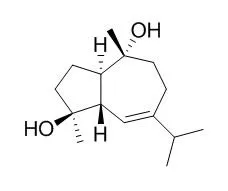| In vitro: |
| Mar Drugs. 2013 Dec 10;11(12):4917-36. | | Cytotoxic, cytostatic and HIV-1 PR inhibitory activities of the soft coral Litophyton arboreum.[Pubmed: 24336129] | Bioassay-guided fractionation using different chromatographic and spectroscopic techniques in the analysis of the Red Sea soft coral Litophyton arboreum led to the isolation of nine compounds; sarcophytol M (1), alismol (2), 24-methylcholesta-5,24(28)-diene-3β-ol (3), 10-O-methyl Alismoxide (4), Alismoxide (5), (S)-chimyl alcohol (6), 7β-acetoxy-24-methylcholesta-5-24(28)-diene-3,19-diol (7), erythro-N-dodecanoyl-docosasphinga-(4E,8E)-dienine (8), and 24-methylcholesta-5,24 (28)-diene-3β,7β,19-triol (9).
METHODS AND RESULTS:
Some of the isolated compounds demonstrated potent cytotoxic- and/or cytostatic activity against HeLa and U937 cancer cell lines and inhibitory activity against HIV-1 protease (PR). Compound 7 was strongly cytotoxic against HeLa cells (CC₅₀ 4.3 ± 0.75 µM), with selectivity index of SI 8.1, which was confirmed by real time cell electronic sensing (RT-CES). Compounds 2, 7, and 8 showed strong inhibitory activity against HIV-1 PR at IC₅₀s of 7.20 ± 0.7, 4.85 ± 0.18, and 4.80 ± 0.92 µM respectively. In silico docking of most compounds presented comparable scores to that of acetyl pepstatin, a known HIV-1 PR inhibitor. Interestingly, compound 8 showed potent HIV-1 PR inhibitory activity in the absence of cytotoxicity against the cell lines used. In addition, compounds 2 and 5 demonstrated cytostatic action in HeLa cells, revealing potential use in virostatic cocktails.
CONCLUSIONS:
Taken together, data presented here suggest Litophyton arboreum to contain promising compounds for further investigation against the diseases mentioned. |
|
| In vivo: |
| Biol Pharm Bull. 1997 May;20(5):511-6. | | Studies on Alismatis rhizoma. I. Anti-allergic effects of methanol extract and six terpene components from Alismatis rhizoma (dried rhizome of Alisma orientale).[Pubmed: 9178931] | Methanol and aqueous extracts (TMe-ext and TAq-ext) from dried rhizomes of Alisma orientale have been screened for activity in experimental models of type I-IV allergies.
METHODS AND RESULTS:
In the type III allergic model, TMe-ext at oral doses of 50, 200 mg/kg showed an inhibitory effect on the direct passive Arthus reaction (DPAR) in rats, while TAq-ext did not. Four triterpenes (alisol A, alisol B, alisol A monoacetate and alisol B monoacetate) and two sesquiterpenes (alismol and Alismoxide) isolated from TMe-ext also exhibited this inhibitory effect. In a type I allergic model, TMe-ext inhibited 48-h homologous passive cutaneous anaphylaxis (PCA) in rats. In a type II allergic model, it was found that TMe-ext inhibits reversed cutaneous anaphylaxis (RCA) in rats. Furthermore, in a type IV allergic model, TMe-ext had an inhibitory effect on the induction phase in picryl chloride-induced contact dermatitis (PC-CD) in mice.
CONCLUSIONS:
These results indicate that Alismatis Rhizoma not only inhibits antibody-mediated allergic reactions but also influences cell reactions and should be recognized as a material for the treatment of allergic reactions, and the anti-type III allergic components are partially attributable to the terpenes mentioned above. |
|






 Cell. 2018 Jan 11;172(1-2):249-261.e12. doi: 10.1016/j.cell.2017.12.019.IF=36.216(2019)
Cell. 2018 Jan 11;172(1-2):249-261.e12. doi: 10.1016/j.cell.2017.12.019.IF=36.216(2019) Cell Metab. 2020 Mar 3;31(3):534-548.e5. doi: 10.1016/j.cmet.2020.01.002.IF=22.415(2019)
Cell Metab. 2020 Mar 3;31(3):534-548.e5. doi: 10.1016/j.cmet.2020.01.002.IF=22.415(2019) Mol Cell. 2017 Nov 16;68(4):673-685.e6. doi: 10.1016/j.molcel.2017.10.022.IF=14.548(2019)
Mol Cell. 2017 Nov 16;68(4):673-685.e6. doi: 10.1016/j.molcel.2017.10.022.IF=14.548(2019)